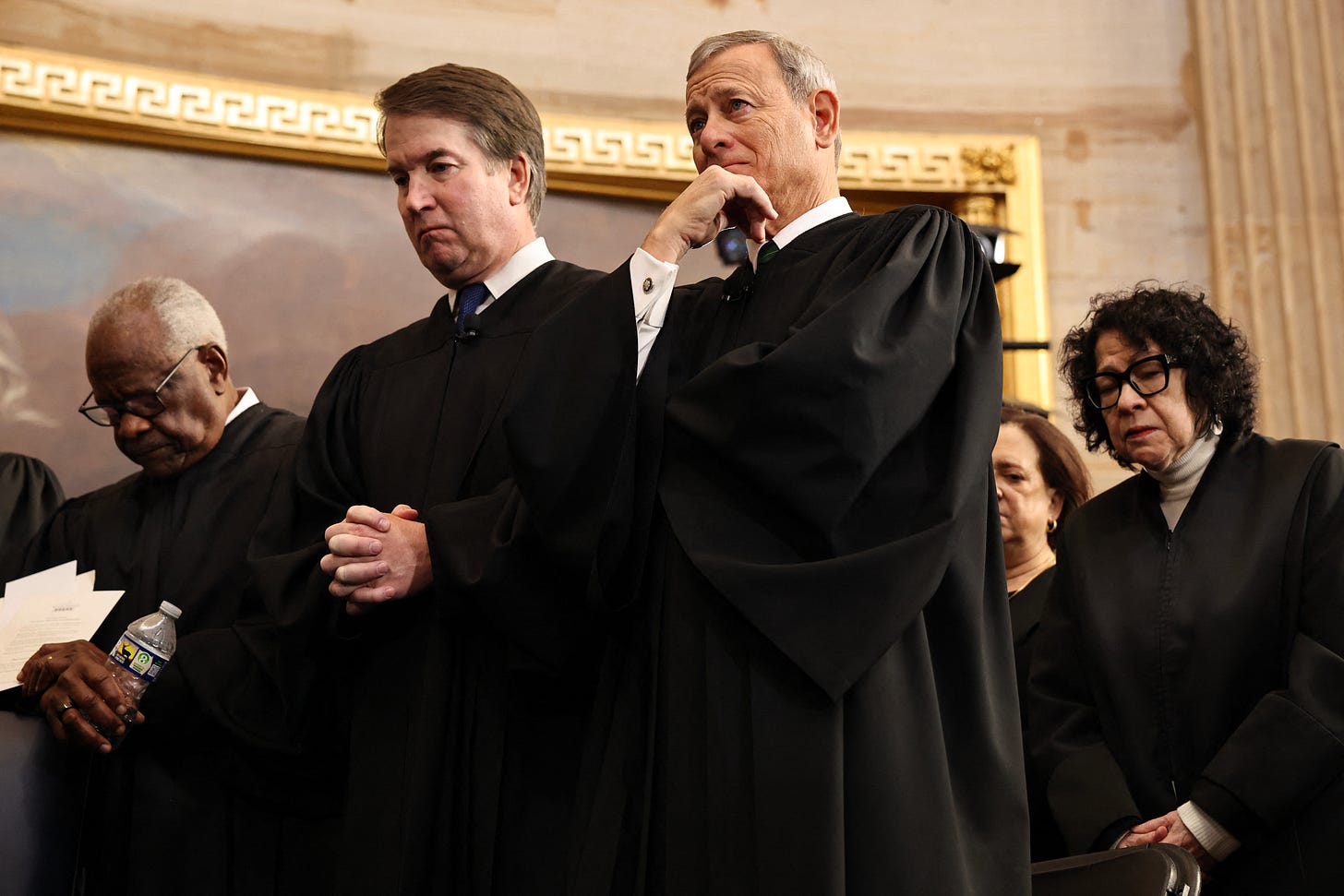
Trump Just Defied the Supreme Court. What Is John Roberts Going to Do About It?
April 14, 2025
Sarah Longwell: Even Trump Voters Are Worried About Tariffs
April 14, 2025
The first American book with the word “Sociology” in its title was Sociology for the South (1854) by the Virginian anti-abolitionist George Fitzhugh. This was one of a large number of screeds from this period that sought to defend the economics, politics, and morality of chattel slavery. Writing under the subtitle “The Failure of Free Society,” Fitzhugh provided a free-wheeling and utterly bad-faith denunciation of the Northern states, their political economy, their allegedly decadent morals, and their devotion to all the false freedoms of industrial capitalism.
Painting this stark picture in turn allowed Fitzhugh to make the core claim of his book: all the failures of free Northern society existed as the mirror opposite of a Southern slavocracy that Fitzhugh felt was the best of all possible worlds. Where other Southern ideologues advanced the limited argument that decisions on slavery should be left to individual states, Fitzhugh went on the offensive and said all states — both South and North — should embrace slavery and its allegedly harmonious social order. Slavery would cure the North of all the social ills that free capitalist labor had created there.
Even at the time, this was a bizarre argument to make. It is not clear if even Fitzhugh himself believed it. His claims about the North were fabricated wholesale and based on selective conjecture; Fitzhugh did not actually visit any Northern state until after the book’s success. His second book, Cannibals All! Or Slaves Without Masters, published three years later, directly contradicts much of the earlier work. Then as now, American ultraconservatism is built on a foundation of bad-faith arguments, illogical claims, nonsense rhetoric, and straight-up weirdness. Bubbling under the surface, though, Fitzhugh shared one other key trait with his fellow conservatives; he was addicted to Karl Marx (and like the most incorrigible addicts, he remained in perpetual denial about that).
The only dedicated biography of Fitzhugh assumes the claims about the failures of “free” capitalist society must have directly resulted from reading The Communist Manifesto, published in 1848. Even if this is not quite true — the Manifesto was not a readily available text in 1850s Virginia — there was still an influence here. The one thing approximating real research that informed Fitzhugh’s book was a close reading of the abolitionist Northern press and, in the pages of Horace Greeley’s New-York Daily Tribune, Fitzhugh almost certainly read and imbibed the work of this daily’s (in)famous European correspondent.
Fitzhugh’s weaponized critiques of the North borrowed from socialism even as he did this to defend a South that Marx knew was far worse than the “free” societies north of the river Ohio. As Andrew Hartman’s new book Karl Marx in America uncovers, the specter of the Rhineland’s favorite son has been haunting Americans from the very outset.
Marx himself had a curiosity about America, present in much of his economic writings; both the Communist Manifesto and Capital regularly incorporate American developments, including slavery, into their broader analyses of capitalism (what Hartman labels the “Marx-America dialectic”). And yet, these economic works remained largely undiscovered in Marx’s lifetime.
His shorter writings for the New-York Daily Tribune, on the other hand, offering views on an array of issues across Europe and the British Empire, attracted a far higher readership. Marx had American followers before he ever had a major European base. He also had detractors; already in the 1870s, proto-McCarthyite red scares were latching onto Marx as a convenient hate figure; the ultimate foreign agitator whose nefarious interference could explain all discontent at home. Marx died in 1883, but his image, his memory and certain constructed ideas of him have continued to have long posthumous careers.
Hartman’s book knits together two narrative strings: right-wing obsessions with Marx that are equal parts paranoid and inaccurate, and a leftist desire to bring Marx “home” to America. This latter narrative is essentially the history of American socialism, and of the ways that divergent leftist strands — utopian vs. scientific, reformist vs. revolutionary, foreign-born vs. domestic, open and democratic vs. doctrinaire and dictatorial, class-determinist vs. quasi-intersectional, Trotskyist vs. Stalinist — have all reworked and redeployed different versions of Marx for their own ends (though as Hartman shows, his followers, then as now, remain trapped by the same debilitating divisions). While conservatives continued to live in fear of him, Marx had clearly sunk roots in American intellectual life by the early twentieth century, and his presence would wax and wane over the subsequent decades.
Post–World War I, the crackdown on homegrown Bolshevism operated alongside, and through, a suppression of Marx; “The golden age of American socialism was exterminated by a nascent national security state that was anti-Marxist by design,” writes Hartman. Marx’s self-appointed heirs also did their own damage, including to themselves. The nascent American Communist Party (CPUSA) adopted wholesale the secretive, conspiracy-prone party structures of the late tsarist Russian Social Democratic Labor Party (RSDLP), adding in the faction-fighting and purges of the post-Revolution Bolsheviks. “Bolshevism was never a good fit in the United States,” Hartman recognizes, but as American communism ossified into undemocratic rigidity, there was no internal means for the party to correct this.
It was the massive failures of US capitalism after 1929, external to any actions of the CPUSA, that revived Marx in America. Hartman traces a flowering of intellectual Marxism in the 1930s; the “quirky perspective” of theologian Reinhold Niebuhr’s Moral Man and Immoral Society in 1932 and Sidney Hook’s Towards the Understanding of Karl Marx: A Revolutionary Interpretation in 1936 shared a desire to go beyond a moribund liberalism incapable of dealing with the realities of the Depression. W. E. B. Du Bois’s Black Reconstruction in 1935 and C. L. R. James’s Black Jacobins in 1938 used Marxist methodologies to brilliantly revise black history; that these are some of the only works from New Deal–era American Marxism to still be in print says much about their superior quality, even if at the time they were too black for a lot of Marxists and too Marxist for the mainstream.
The 1930s revival was not to last; Hook abandoned Marxism and moved to the center, while Niebuhr — never a Marxist to begin with — walked a fine line between pacifism and liberal anti-Communism. That the Cold War put the knife to homegrown American Marxism is hardly news to anyone. More surprising are the myriad ways conservative ideologues couldn’t help but look to Marx.
The moral philosopher Russell Kirk railed against Marx in his most famous book, The Conservative Mind, in 1953; Kirk doesn’t seem to have actually read Marx and invented quotes and mis-ascribed ideas to him in an effort to conflate the New Deal with Marxism. The Marxism that exists inside the heads of American conservatives is always scarier than actually existing American Marxism. Hartman also observes the jealousy that American conservatives have often experienced when they thought about Marx; they, too, longed to have powerful theorists who could sit at the head of revolutionary political movements. Other emotions seemed to be at play too; a disgust for Marx along with an inability to stop looking at the thing they claimed disgusted them.
From Fitzhugh to today, American conservatism has constructed fake visions of enemy societies — the sinful Northern states, the Soviet Union, “shithole countries,” and Democrat-controlled big cities — but then can’t stop looking at the imaginary wreckage in their own rearview mirrors. Conservative visions of what Marx said (or what they think or wished he said) are key ingredients of this. Hartman closes out with a rapid overview of the greater works and key figures of late-twentieth and early twenty-first-century American Marxism; Raya Dunayevskaya, William Appleman Williams, Angela Davis, Fredric Jameson, Cedric Robinson, up through the (re)birth of Millennial Socialism. Real Marxism, with real things to say, exists alongside the imaginary Marx of his enemies.
The bedrock of conservative readings of Marx is that this German theorist is always too foreign an implant for American soil. The irony is that this same claim as to Marx’s “foreignness” is made in all the places where Marxism takes root. The flipside of socialist internationalism is that conservatives of the world unite via their desire to always expel Marx from their respective nations. Even in the places where Marxism has made itself clearly at home, it is apparently still too foreign (or too much an allegedly irrelevant relic from the nineteenth century) to be welcome or needed. Hartman himself is attempting to undo that, in order to show that Marx and Marxism have, in fact, made space for themselves within American political traditions.
In so doing, though, he comes close to constructing here an American-exceptionalist Marx, a Marx for whom America was the most singular and important country in the world (downplaying how much first Germany, and then Britain and Ireland, mattered far more). That “Karl Marx had thoughts about America” is plainly true; like his comrade Joseph Weydemeyer, who had fled Germany for Missouri, Marx, too, felt himself being “pushed into the American bourgeois shit.” The danger, though, is to present these “thoughts” and “bourgeois shit” in isolation, creating a Marxism that doesn’t need to be compared to other national contexts.
Recent books on Marx have oscillated between presenting him as a singularly nineteenth-century figure or as a timeless savant whose ideas are applicable across all of the spaces and times of capitalist modernity. Hartman’s approach, disaggregating the man from the posthumous deployment of his later ideas, allows him to stand on both sides of that divide. The result is an astute and politically useful book about a vital strand of American intellectual thought.
Great Job Aidan Beatty & the Team @ Jacobin Source link for sharing this story.


















